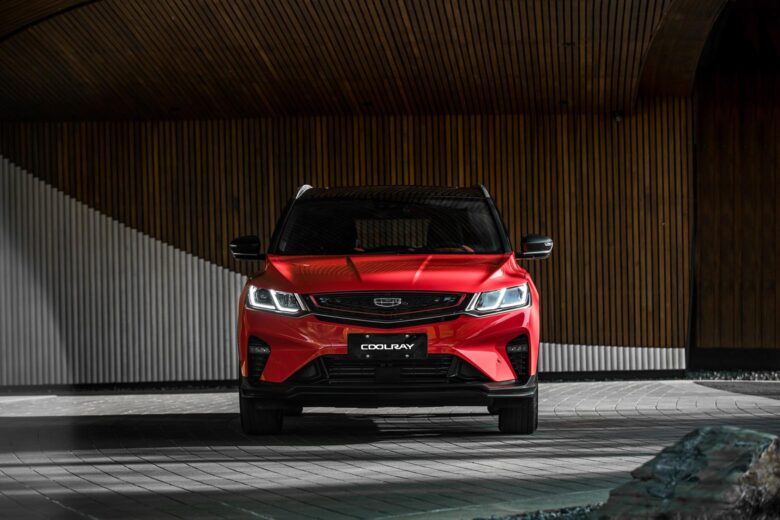In the high-octane world of automotive giants, Geely Holding Group has revved up from its origins as a modest Chinese enterprise to a dominant player on the international stage. Masterfully steering the complicated course, Geely cars blend cutting-edge technology with attractive designs, propelling itself forward with lightning-fast speed.
2M
vehicles sold per year
Marked by strategic mergers and partnerships, Geely Group has quickly ascended the automotive world. Now synonymous with innovation, style, and technological prowess, Geely cars are infused with a wealth of design expertise and production experience as they grow to span global markets with meticulous precision.
This remarkable journey has cemented Geely Autos as a major player in the industry, but its vision for the future is defining the next era of automotive innovation.
At a glance
| Brands | Volume (est.) | % of Group (est.) |
| Geely Auto | 1.05 million | 44.7% |
| Volvo | 615,100 | 26.2% |
| Lynk & Co | 180,100 | 7.7% |
| Geometry | 149,400 | 6.4% |
| Proton | 141,400 | 6.0% |
| Zeekr | 71,900 | 3.1% |
| Livan | 56,140 | 2.4% |
| Polestar | 51,500 | 2.2% |
| Smart | 31,200 | 1.3% |
| LEVC | 2,500 | 0.1% |
| Lotus | 600 | 0.02% |
| Radar Auto | Unavailable | |
| Farizon Commercial | Unavailable |
About Geely Holding Group
Geely Holding Group cruises onto the global auto stage as a trendsetter, delivering a fleet of sleek, tech-forward vehicles to diverse markets worldwide, with innovation in the driver’s seat and ambition under the hood.

History of Geely Holding Group
In 1986, Eric Li Shufu founded Geely as a relatively modest company focused on producing refrigerator parts. Mr. Li’s vision stretched far beyond the horizon, eventually growing Geely automobile holdings into one of the world’s largest car companies.
A giant shift forward came in 1997 when Geely Auto became China’s first privately owned auto manufacturer, with its first model rolling off the Geely brand lines in 1998. And just four years later, Geely China cars sped onto the list of China’s top ten car brands.
Shortly thereafter, Zhejiang Geely Holding Group Co. was established and the hunger for expansion grew. In 2010, Geely acted on its international initiative and purchased 100% of Volvo Cars from the iconic American car brand, Ford Motor Company.
Once again, Geely Holding Group’s success was unstoppable. It became a Fortune 500 company in 2012, and now with the Geely Volvo acquisition, there was no doubting Geely Automotive’s presence as a serious player in the international car industry.
Geely Group has continued to expand at a ferocious pace, racing into major partnerships with Lotus Cars and Proton, as well as a joint venture with Mercedes-Benz to produce Smart brand vehicles.
As if that weren’t enough to keep the tank full, the Geely global brand accelerates into the future with a relentless pursuit of new energy vehicles, including battery electric cars, plug-in hybrids, and methanol commercial trucks. It has launched new domestic lines like Radar Auto and luxury car brand Zeekr, as well as international EV automakers Polestar and Lynk & Co.
Although Geely autos aren’t on the list of the best classic cars, the company is shaping up to create some of the world’s most popular cars with future-forward technology.
Understanding group synergy
The ability of multinational companies to leverage knowledge and production across brand names has become a staple in many industries, with automotive being one of the greatest examples. Volkswagen Group might be the most well-known, using a modular platform for cars across all types of lines from Audi, Porsche, Bently, and Lamborghini.
At the beginning of Geely cars around 20 years ago, the lineup was limited and production was mainly domestic. As Geely Holding Group has blossomed beyond borders, so has its ability to utilize shared research, development, and production.
The Geely Volvo Scalable Product Architecture (SPA) platform was one of the first examples used by its Swedish car brand that made for a streamlined production within the Volvo brand, used on many variations of the XC90, S90, V90, XC60, S60, and V60.
At the same time, Geely has two platforms, the Compact Modular Architecture (CMA) and B-segment Modular Architecture (BMA), that stretch across the Geely Autos lineup, now on no less than six Geely cars.
Now, all of these versatile chassis have broken the brand barrier, sitting under the face of the Polestar, Lynk & Co, and Proton electric cars. Yet that pales in comparison to the next-generation chassis of Geely brand cars.
The Sustainable Experience Architecture (SEA) platform is a battery-electric platform that can be modified for rear-wheel and all-wheel drive vehicles, with five different core versions spanning every market segment from compact cars to executive cars, and even into commercial vehicles. It is the future of Geely motors across every Geely brand.
Even more intriguing, the Geely Company calls the SEA platform an “open-source” option, inviting other auto manufacturers to utilize this in their production runs. Geely is not only creating synergy within the organization but is hoping to become a third-party supplier for one of the most critical elements of any automobile.
In a little more than two decades, Geely has shot from a new entry to one of the world’s leading car brands that’s charged up and ready for the next generation of automotive endeavors. Maybe someday they’ll continue to reach for the stars and make our list of the most expensive cars.
Geely Holding Group is stretching across the world, ready to cover every stretch of the road with the new energy vehicle of your dreams.












